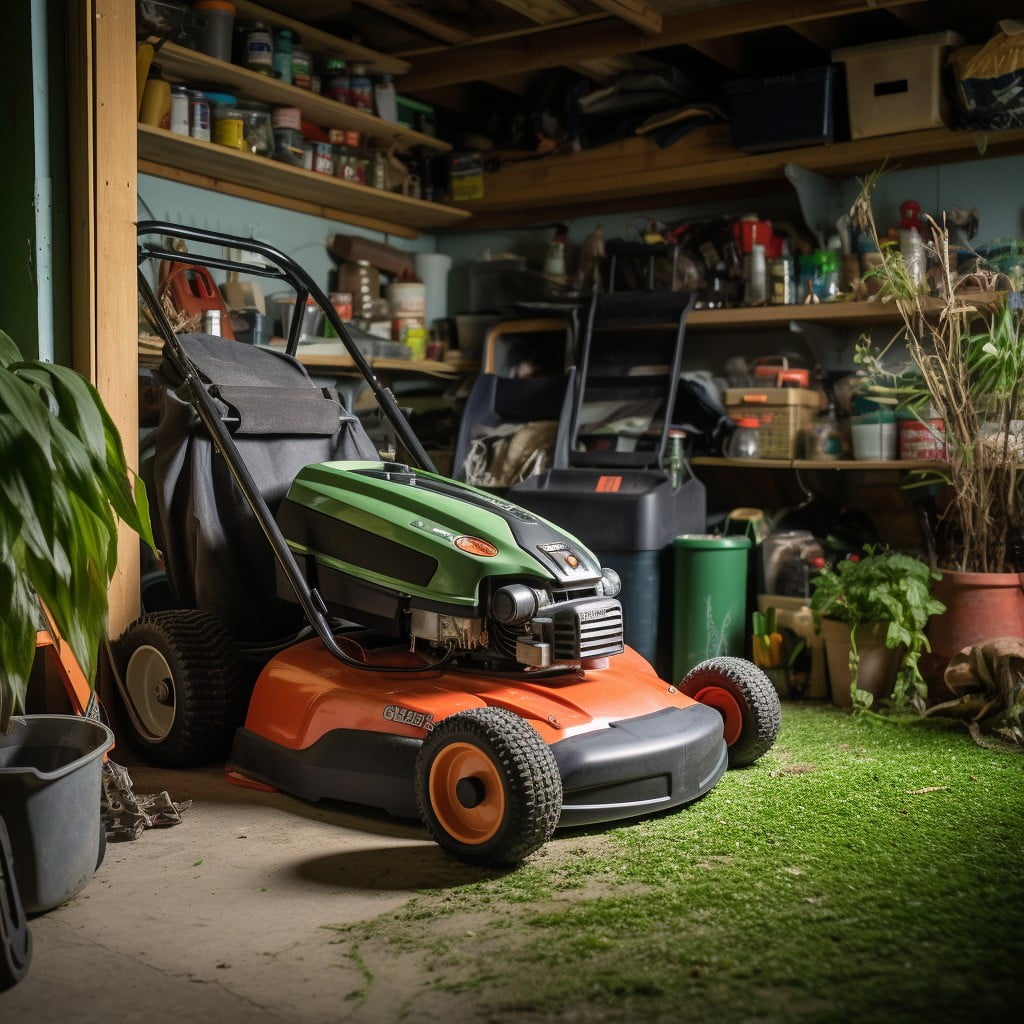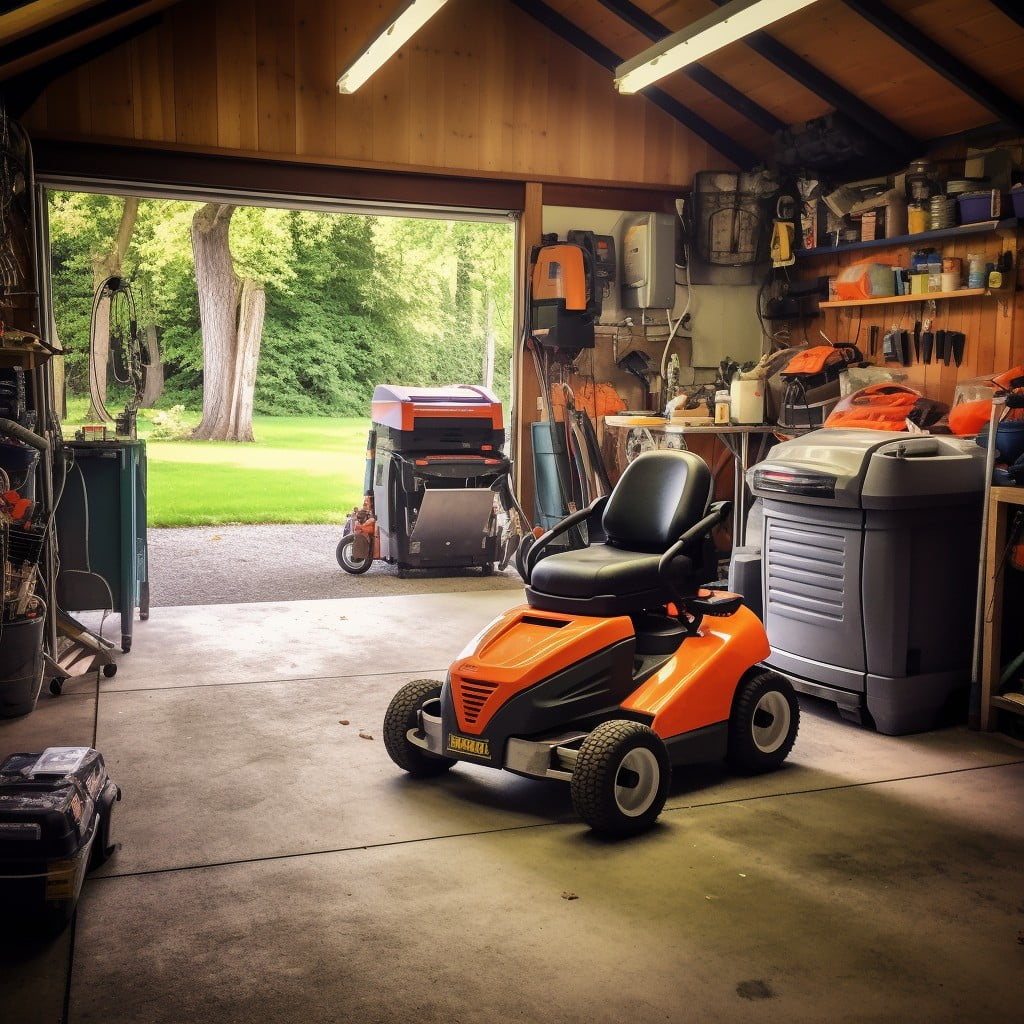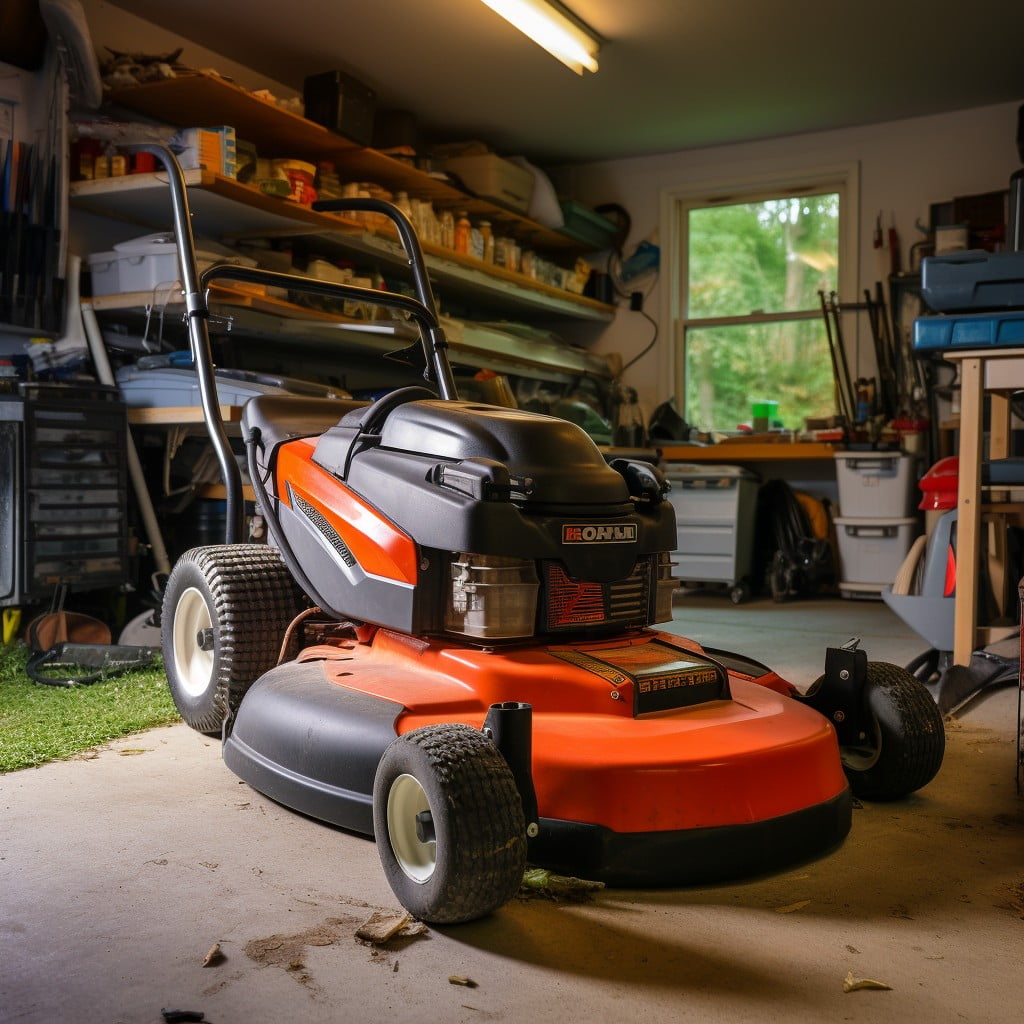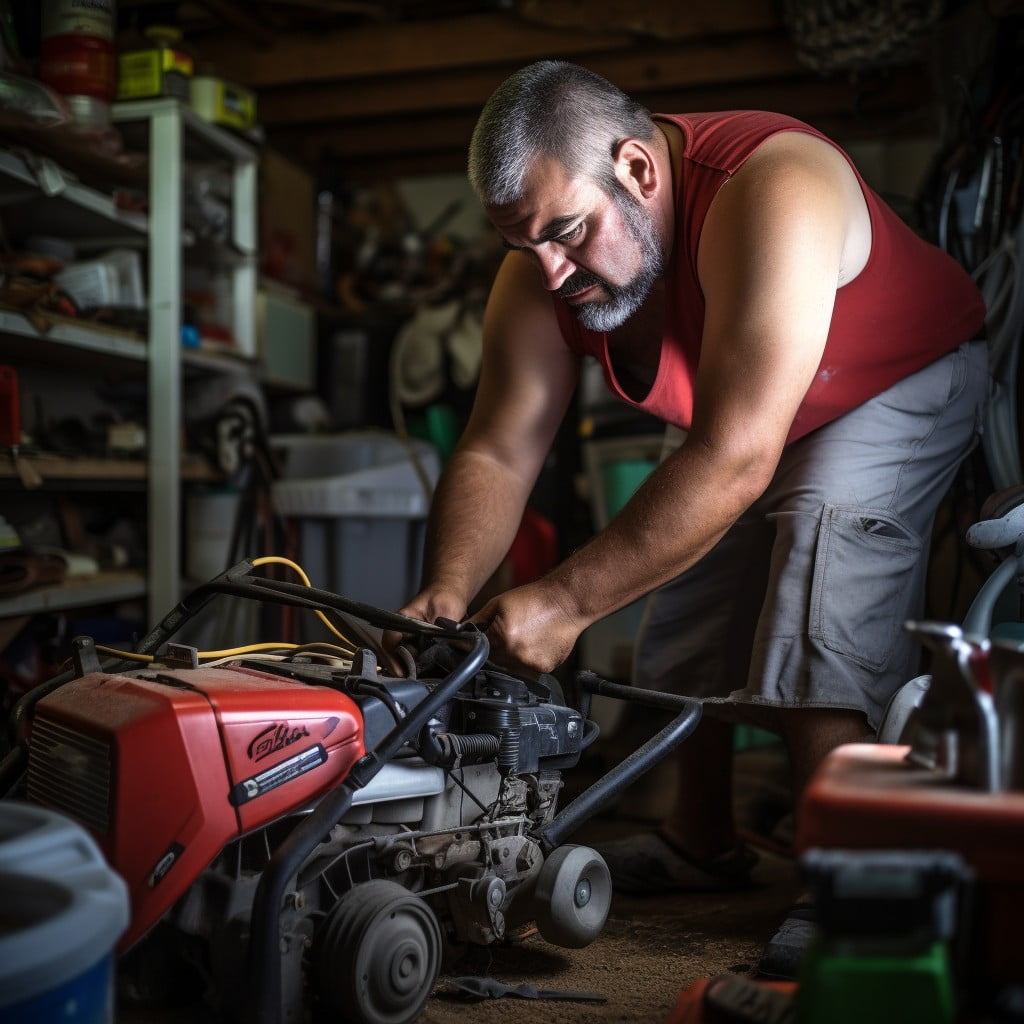Discover practical and space-saving techniques to effectively store your lawn mower in the garage without compromising its longevity or functionality.
Storing a lawn mower in the garage can be a challenge, especially if space is limited. However, with a few clever storage solutions, you can easily fit your lawn mower in your garage without sacrificing any valuable space.
From utilizing wall space to maximizing floor area, this article will provide you with a comprehensive guide on how to store your lawn mower efficiently in your garage.
So, whether you have a small push mower or a larger riding mower, you’ll find practical and effective storage solutions here.
Read on to discover how to keep your garage organized while ensuring your lawn mower is easily accessible and ready for use.
Key takeaways:
- Select easily accessible location in garage for storage.
- Ensure dry, well-ventilated area and remove flammable materials.
- Thoroughly clean mower before storage to prevent corrosion.
- Remove battery to prevent discharge and protect electrical components.
- Lubricate parts for extended storage to reduce friction and maintain function.
Choosing the Right Spot in the Garage for Lawn Mower Storage

To make the most out of your garage space, select a location that is easily accessible but also allows room for other items. Ensure there’s ample space for you to comfortably maneuver the lawn mower in and out without bumping into other objects.
An area close to the garage door can be a suitable spot, eliminating the need to navigate through a crowded garage. If space is limited, consider a corner spot where the mower can be tucked away neatly.
It’s also essential to think about the floor surface. A flat, even surface is preferable to prevent any tipping or rolling. If the garage floor slopes towards the door, use blocks or chocks to secure the wheels.
Lastly, consider ventilation. Gasoline fumes can build up, creating a potential hazard. Positioning your mower near a window or vent can help dissipate any accumulated fumes. Ensure it’s not near any flame sources to prevent any risk of fire.
By taking these points into consideration, you can optimize your garage space and ensure your mower is stored safely and efficiently.
Preparing Your Garage for Lawn Mower Storage

Before stowing away your reliable grass cutter, make certain you have a designated space that is suitable and safe. A spot away from exit paths is ideal to prevent accidents and obstruction.
Ensure the area is dry and well-ventilated to reduce the chance of rusting and corrosion—a common concern when machinery is left idle. Clear out any flammable materials nearby as idle engines can sometimes leak and pose a fire risk.
If your garage floor is uneven or sloped, considering using a chock for the mower’s wheels to keep it stationary. Organizing your garage space for your lawn mower not only promotes longevity of the mower but also enhances safety within the garage.
Cleaning the area removes potentially hazardous elements and enables easy maneuvering when you need to use or maintain the mower. Lastly, be mindful of the mower’s position relative to other items in your storage—strive for easy accessibility without compromising on safety.
Cleaning Your Mower Before Storage

To ensure your mower’s longevity, a thorough cleaning is a fundamental part of the preparation process before leaving it in storage. A clean mower is less likely to have mechanical issues, as dirt, grass clippings, and debris can corrode the materials and compromise the machine’s efficiency.
Follow these steps to clean your lawnmower appropriately:
- 1. Begin by removing surface dirt and grass utilizing a soft brush or compressed air, this will prevent any old grass from sticking to the mower.
- 2. For stubborn dirt, use a soft cloth soaked in warm soapy water. Avoid soaking any electrical or fuel system components.
- 3. Pay particular attention to the underside of the deck, removing all grass buildup, which can lead to rust over time.
- 4. Rinse the mower with a slow stream of water, but avoid using a high pressure which might force water into areas where it could damage the engine.
- 5. Make sure you dry the mower completely before storing it. Leaving any moisture can quickly lead to rust and corrosion.
Neglecting this step can affect not only the mower’s performance but also its lifespan, so be sure to thoroughly clean your mower before storage.
Remove the Battery Before Storage

Detaching the battery is a vital part of storing your lawnmower. By doing this, you prevent the possibility of the battery discharging over time. It also shields delicate electrical components from potential damage caused by extreme temperature fluctuations.
Here’s a quick step-by-step guide on how to safely remove it:
- Always remember to use gloves and eye protection. Safety first!
- Locate the battery. Most often, it can be found beneath the seat or the hood.
- Disconnect the black, or negative battery cable first to prevent accidental sparking.
- Next, disconnect the red, or positive cable.
- Once both cables are disconnected, simply lift the battery out of its seat.
After removal, store the battery in a cool, dry location where it won’t be exposed to freezing temperatures. Utilize a trickle charger periodically to maintain its charge during the off-season. In this way, both your mower and its battery can remain in prime condition, ready for summer’s green lawns.
Lubricating Parts for Extended Storage
Before storing your lawn mower for an extended period, it’s crucial to lubricate certain parts. This process helps to reduce friction and maintain optimal functionality.
Firstly, focus on the engine components, such as spark plugs and pistons. Using a storage-grade oil, apply just enough to coat these parts. Engine oil ensures your mower’s next startup is smooth and the components aren’t prone to corrosion.
Next, turn to the deck and blade area. Spray a layer of rust inhibiting lubricant to prevent corrosion.
Lastly, don’t forget the cables and controls, especially if your mower is self-propelled. These require silicone-based lubricant to maintain their elasticity and responsiveness.
Remember, each lawn mower model may have specific lubrication requirements. Always refer to your owner’s manual for instructions specific to your model. Remember, the aim is to ensure parts move freely without undue friction when you retrieve your mower from storage.
How to Winterize Your Lawn Mower for Storage
Before storing your lawn mower for the winter, it’s important to winterize it to ensure its longevity and optimal performance. Follow these steps to prepare your mower for its winter rest:
- Clean the Deck: Carefully remove grass clippings, dirt, and debris from the mower’s undercarriage to avoid moisture retention which can cause rust.
- Drain the Fuel: Leaving fuel in the tank can damage the carburetor. Run the mower until it’s out of gas or use a siphon.
- Change Oil as Needed: Check the manufacturer’s recommendations. As a rule, if the oil is dark or dirty, change it.
- Spark Plug Replacement: Remove and replace the spark plug to avoid old fuel from entering the cylinder.
- Sharpen the Blades: Sharp blades save fuel and cut grass more efficiently. Sharpen the mower’s blade, but make sure to disconnect the spark plug first for safety.
Performing these steps will help lengthen the lifespan of your mower, ensuring it’s ready to roll when the grass starts growing again.
How to Cover Your Lawn Mower in the Garage
Opt for a cover specifically designed for lawn mowers to ensure fitting accuracy. These are usually made from heavy-duty, durable material such as polyester that protect against dust, dirt, and weather elements.
Remember to only put the cover on when the mower is clean and completely cool to prevent damage. Try to prevent the cover from touching the floor of the garage, as it can gather dust and potentially transmit this back onto the mower.
A cover not only preserves your equipment, but also contributes to the cleanliness of your workspace. It’s an easy yet effective step in maintaining the longevity of your lawn mower while stored in your garage.
Lawn Mower Storage Ideas
Exploiting wall space can prove to be a smart move for lawn mower storage. By mounting shelves or using heavy-duty hooks, you can elevate your mower creating more available floor space. For smaller, light-weight mowers, overhead storage can be an efficient solution.
If your lawn mower is foldable, take advantage of this feature and fold it when not in use. This simple step can drastically reduce the occupied space, leaving room for other items.
Consider special storage units made for lawn mowers. They come in various shapes and sizes and offer optimal protection against dust and other garage elements.
Portable storage sheds or containers are excellent options for those with extra-large garages. These units can comfortably house your mower and other gardening tools.
Lastly, corner storage can be a lifesaver. Designating a specific corner in your garage to store your mower ensures it has a ‘home,’ decreasing the chance of it being moved around or damaged by other items in your garage.
Best Practices for Maintenance and Care of Your Lawn Mower in the Garage
To ensure the optimum performance and longer lifespan of your equipment, following some simple best practices is key.
1. Regular Cleaning: Dirt and grass clippings can cause damage over time. Clean the deck and blades thoroughly after each use.
2. Address Rust Early: If you spot any rust formation, treat it immediately. Use rust converters or preventatives to arrest the rust from spreading further.
3. Change Oil: For best performance, change the engine’s oil at least once per year. Refer to your owner’s manual for the correct grade of oil.
4. Filter Maintenance: Both air and fuel filters need regular inspection and replacement, according to the manufacturer’s suggestions.
5. Keep Blades Sharp: Dull blades tear grass rather than cutting it. Always ensure blades are sharp and not damaged.
6. Use Fresh Fuel: Stale fuel can be detrimental to your mower’s engine. Empty out old fuel if you’re storing the mower for a prolonged period.
7. Adherence to Manufacturer’s Advice: Each model comes with a specific set of instructions. Always refer to the manufacturer’s manual for further details on care and maintenance.
Remember, proper maintenance can prolong your lawnmower’s life, saving you both time and money in the long run.
FAQ
Is it safe to store lawn mowers in the garage?
Yes, it is safe to store lawn mowers in the garage as it protects them from the elements and potential theft, and also helps in saving space.
Should you store your lawnmower with gas in it?
No, you should not store your lawnmower with gas in it as it might require a professional carburetor cleaning or pose a fire hazard, especially if stored indoors.
How do you store lawnmowers when not in use?
When not in use, lawnmowers can be stored in a garage, providing insulation and protection from potential rusting or damage due to harsh weather.
What are optimal temperature conditions for storing a lawnmower in the garage?
The optimal temperature for storing a lawnmower in the garage is between 40-85 degrees Fahrenheit to prevent fuel condensation and battery problems.
Are there any specific safety measures to be taken when storing a lawnmower in the garage?
Yes, when storing a lawnmower in the garage, it is essential to disconnect the spark plug, empty the fuel tank and ensure that the blades are properly secured to prevent accidental injuries.
Is there a specific orientation or positioning recommended when storing a lawnmower in the garage?
When storing a lawnmower in the garage, it's recommended to keep it in a dry, cool area, preferably off the floor to prevent rust and damage from any potential flooding.